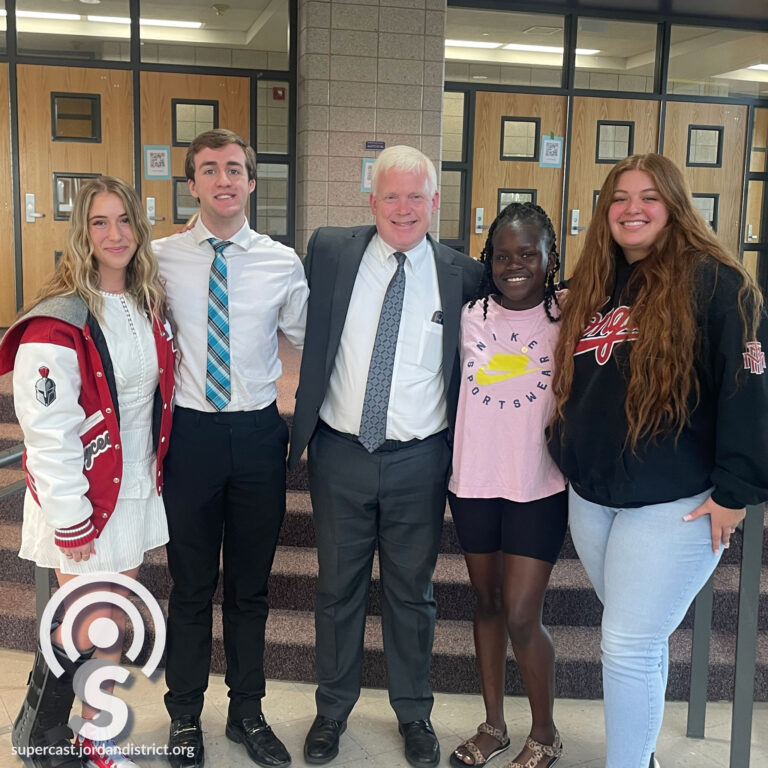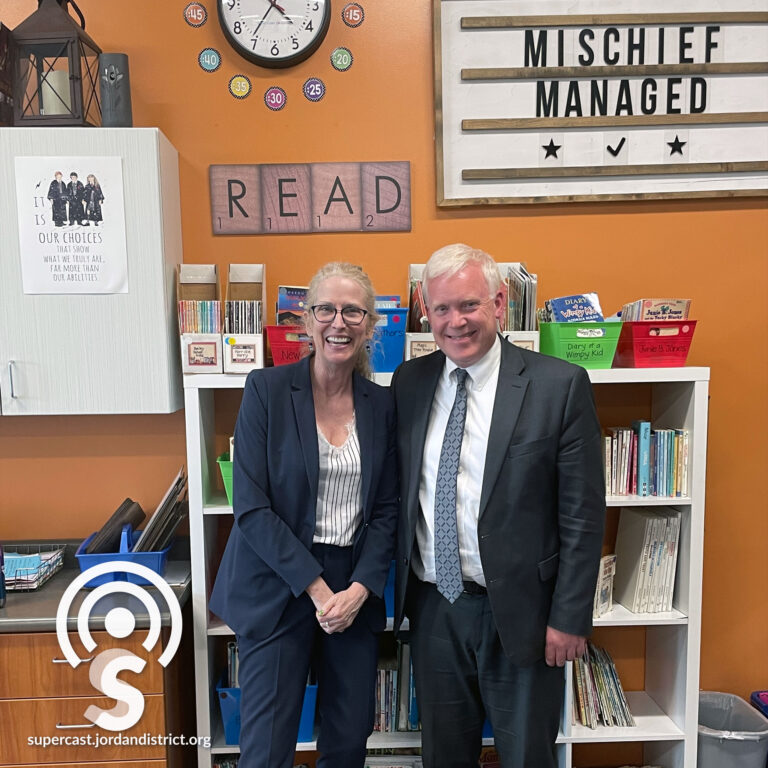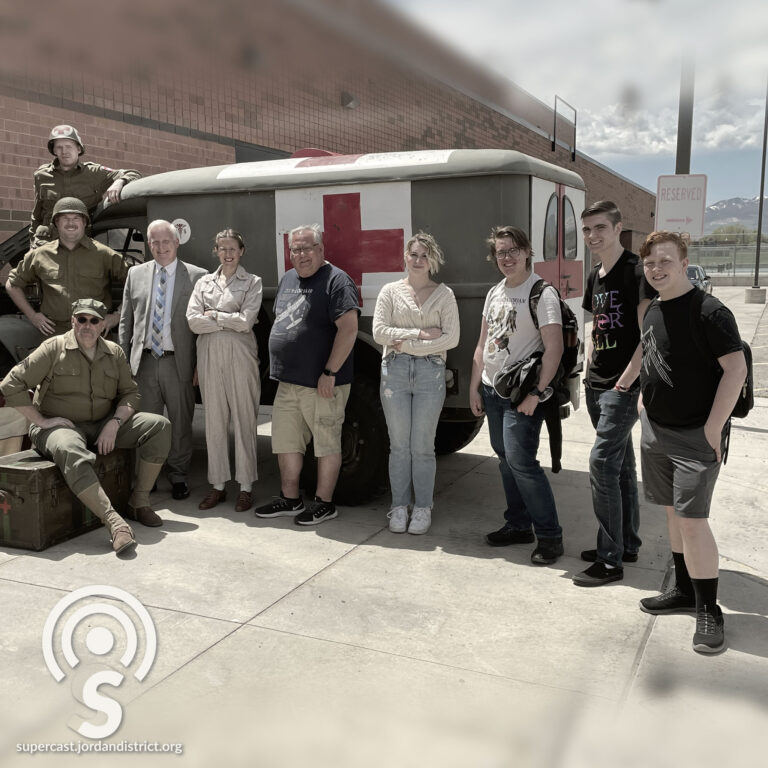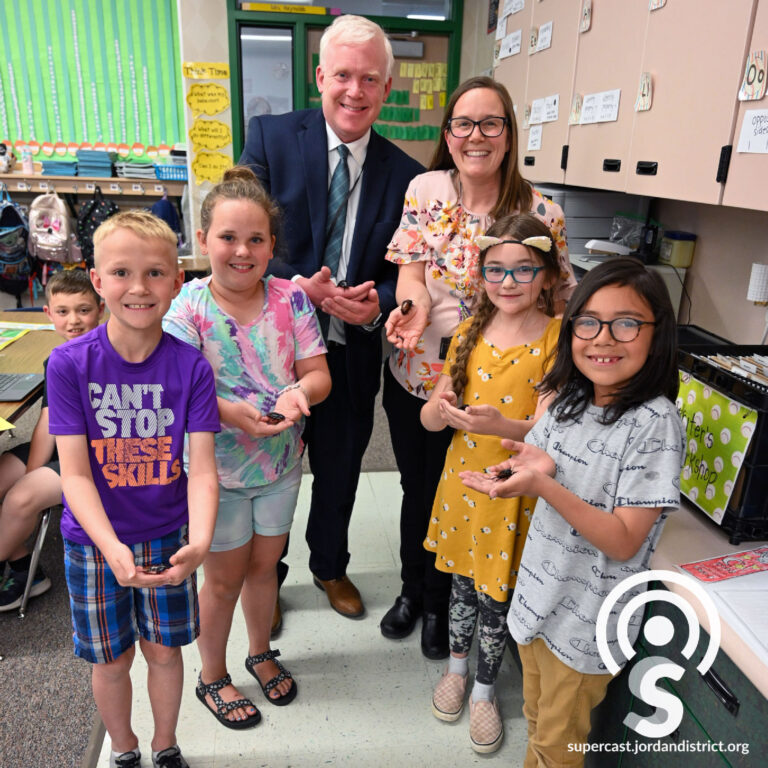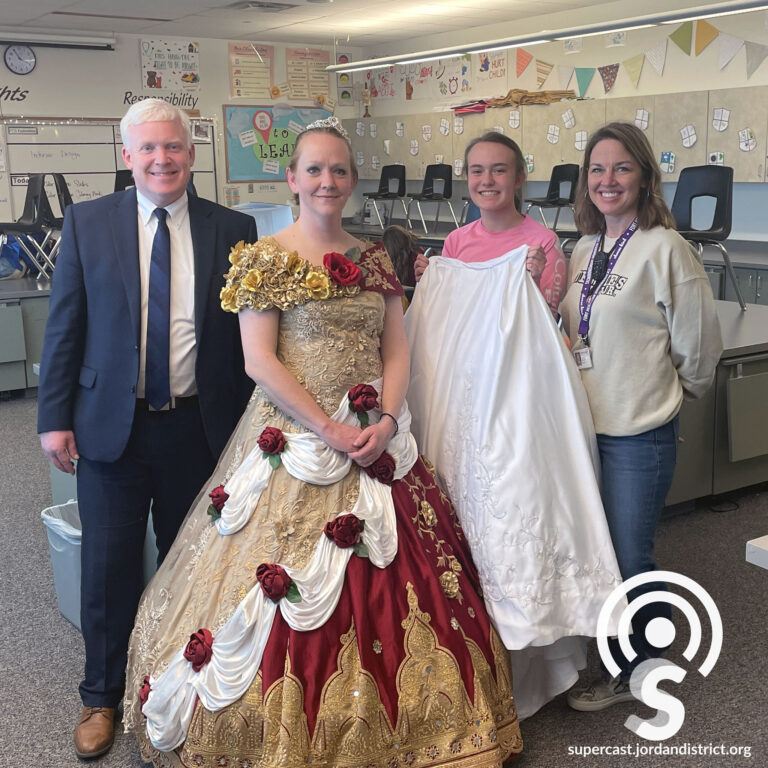It is a time to reflect on memories that will last a lifetime, while looking forward to the future.
On this episode of the Supercast, we sit down with some members of the graduating class of 2023. Find out who inspired them to succeed and what’s next as they make new memories in their journey beyond high school.
Audio Transcription
Anthony Godfrey:
Hello and welcome to the Supercast. I'm your host, Superintendent Anthony Godfrey. It is a time to reflect on memories that will last a lifetime while looking forward to the future.
On this episode of the Supercast, we sit down with some members of the graduating class of 2023. Find out who inspired them to succeed and what's next as they make new memories in their journey beyond high school.
Introduce yourself and tell me about a teacher or adult that's been impactful for you at school.
Linda:
I'm Linda and I'm from Riverton High School. And a teacher that has been impactful for me through school. I'm so grateful because I had the opportunity to have so many great teachers in my life. I remember in third grade I had my teacher, Ms. Colgan, and even though we were homeless or the different things that we would struggle with, she was always so kind and always was so loving and it just always made my day brighter.
I remember one thing, she brought me snow boots for the winter because I had no snow boots. And I will never forget that moment because she showed her love and her kindness. At the high school, I've had so many great teachers, Ms. Elliot, Brett Nelson, and my wonderful counselor, Mr. Christensen. Having these great teachers, having them not judge me, and be there for me, and know that I'm capable of greater and my grades don't define me, my past doesn't define me, and that I'm going to grow into a great person. Just having them and their great example has helped me a lot.
Anthony Godfrey:
He's taught you there's always that next step forward. I love that. That's great. What advice do you have for those who are entering high school or their senior year?
Linda:
I would say that life as well as high school is going to be what you make it. So I think oftentimes whatever life throws at us or whatever we go through like in middle school coming in, again like I said it won't define you. And if you want to have a fun time in high school, if you want to do all the things or want to grow or want to go into a certain career, just do the work to do that. Because anything in life is going to be work, it's just about how much you're willing to put into it.
High school is such a great thing and I say just work hard and get there because it's gonna flash by quicker than you know. I remember someone saying that to me when I was in like sixth grade and I was like "ha ha ha, like you're funny" and now I'm like "Oh, ha ha, it wasn't funny. Just kidding.” But just be willing to put in the work because you can do great things. It's just about how much work you're willing to put into it. And anybody's capable of great things and you've got this.
Anthony Godfrey:
I love that. And just so you know, the time will go faster and faster. Take it from me.
Linda:
Okay. (laughing) Wow.
Anthony Godfrey:
Introduce yourself and tell me about a teacher or adult who's had an impact on you from kindergarten through 12th grade.
Graycee:
I'm Graycee and I'm from Mountain Ridge High School. I've had a few teachers who have impacted me throughout my high school experience. I've had Cambria Robertson and Shane Busdicker. They helped me a lot my sophomore year. You know, going through COVID it's kind of hard to figure out who you are as a person, a student, and trying to make friends while, you know, going in person for school, then switching to online, and Zoom all the time. And they really helped me to get confidence in myself and to understand that everything will be okay, even when it's hard just to know that you can always push through life.
And then my student government advisors, Richard Hoonakker and Shaila Keck, have taught me so much about leadership, dedication, motivation, time management, just all the skills that I feel like I need for a career path just to get through life in general. And I'm so grateful to them for their leadership to me and they're such a role model in my life. I'm just grateful that I had the opportunity to have them as my teachers.
Anthony Godfrey:
Great teachers and great lessons. Tell me what advice do you have for students who are entering high school or entering their senior year?
Graycee:
I would say the most important thing is just, be yourself like everyone else is saying, but also put yourself out there and get involved, even if it's scary and uncomfortable. You can always grow when you push yourself past your comfort zone. And I've learned so much about myself doing student government or being on the cheer team. It's just something you wouldn't expect, but you're so grateful for the outcome afterwards because you're a completely different person after. And so without forgetting about your fears and all the doubts in your head, just stop being such a critic of yourself and just have fun and get to know people. Don't be afraid that you're being judged by other people. Just do you.
Anthony Godfrey:
Great advice, thank you. Introduce yourself, tell us your name and the school you're graduating from, and then tell me a couple of things. A favorite teacher or adult that had an impact in your life from kindergarten to 12th grade, and then advice that you have for anyone who is either going to be a senior next year or starting high school next year.
Luseane:
Perfect, hello, my name is Luseane. I'm graduating from Valley High, and one teacher, or actually a couple teachers, from kindergarten up to senior year, I would wanna say number one, my mom, of course. She's a teacher, she was teaching at Syracuse Arts Academy, and she was my theater teacher, but I want to say thank you, Mom, for everything, I mean, giving me life, number one. And number two, letting me sneak into your class and get snacks during my other classes. Also, I want to say thank you to Billy Zumbrun, that's my counselor from Clearfield High. He helped me strive to be better in every aspect of life, to show up to class, to actually put an effort after my dad had passed.
And I also want to thank Crivello and Bany from Valley High that have given me a lot of opportunities to be myself and to make up a lot of credits whenever I have fallen short a little bit.
Anthony Godfrey:
Okay. And what advice do you have for those who are entering high school or entering their senior year?
Luseane:
Honestly, I would say just to be yourself. There is no one else you can describe to be. You can look at your peers, and you can look at your friends, and foes because who knows? But look at everybody but also remember that you don't have to try to be anybody but yourself. You don't have to impress anybody to make friends. You don't have to be the best in your class or the funniest. Just live a little, you know what I'm saying?
Anthony Godfrey:
Be yourself, live a little.
Luseane:
Yeah.
Anthony Godfrey:
But you are the funniest, aren't you?
Luseane:
I mean, I don't know, I'm not gonna brag. (laughing)
Anthony Godfrey:
All right, thank you very much.
All right, introduce yourself and tell me about a teacher or adult who's had an impact on you, kindergarten through 12th grade.
Trevor:
I am Trevor and I am the valedictorian of Copper Hills High School. One thing about me is I ask a lot of questions and they're always really deep questions that are not exactly inside the school curriculum. So the best teachers for me are the ones that put in the effort and have the knowledge to answer all the questions I ask. So Ms. Messervy, my calculus teacher, and Ms. Edelman, my psychology teacher, probably some of the favorite teachers I've ever had. Another teacher I really like is Mr. Taylor, my choir teacher because he's always so fun and so engaging while still being able to effectively and quickly convey all the material to his large classes.
Anthony Godfrey:
So they've had a big impact on you.
Trevor:
Yes.
Anthony Godfrey:
Tell me what advice do you have for students who are just entering high school or entering their senior year?
Trevor:
So I have two pieces of advice. The first is that time is by far the most valuable resource you have, and you do not want to waste a second of it. Every second you have is a second that you'll never get back and you've got to do what you can with the time you've been given because it's going to go away very quickly.
Anthony Godfrey:
You have me regretting all that time I spent on TikTok this morning. (laughing)
Trevor:
That's why it's called TikTok.
Anthony Godfrey:
That's right.
Trevor:
Second piece of advice is to avoid apathy. Especially for all you seniors out there, as you go into your senior year, you're going to feel the urge to give up, to stop trying. But you've come this far and you cannot give up at this point. There is, you have so much potential and so much you can do with your life if you only continue to care.
Anthony Godfrey:
Okay, great. Great advice. Thank you.
Stay with us. Up next, we listen in on some graduation speeches from the Class of 2023.
Break:
Are you looking for a job right now? Looking to work in a fun and supportive environment with great pay and a rewarding career? Jordan School District is hiring. We're currently filling full and part-time positions. You can work and make a difference in young lives and education as a classroom assistant or a substitute teacher. Apply to work in one of our school cafeterias where our lunch staff serves up big smiles with great food every day. We're also looking to hire custodians and bus drivers. In Jordan School District we like to say people come for the job and enjoy the adventure. Apply today at employment.jordandistrict.org
Linda:
My name is Linda Curtis and I'm from Riverton High School. Good evening, class of 2023. I am honored to be here. Today marks one of the most significant milestones in our lives. Before we put on our big kid pants and step out onto the big world, I hope we all remember this important quote, "Don't forget where you came from and never lose sight of where you're going."
A few short years ago, I thought graduating high school would be impossible. Thankfully, through hard work, dedication, great teachers, and a wonderful counselor, shout out to Mr. Christensen, you're a G for real, I get to do so today.
My utmost gratitude, however, goes to my parents, Brian and Shay Curtis. Even though we found each other later in life when I was 16, I can say they have shaped me far more than I can put into words. I would not be the person I am standing before you today without them. I am so blessed to have their great example in my life and I thank God every day because I am so blessed. They have given me constant support, love and guidance. I went from believing I would never amount to anything to being able to look at myself in the mirror. I am who I am today because of their great example.
I can tell you firsthand what blowing off school and your core values will do to you and your future families. In the neighborhoods where I grew up and in my biological family, survival was the most important thing, not traditional education. No one really graduated high school in my neighborhood nor in my biological family. Most of my childhood friends have dropped out of high school, are in jail, turned to drugs and violence, sadly passed away, or just living to survive.
My GPA before I came to RHS was a 1.25. Through hard work, a home filled with love, and a caring neighborhood and community, I'm currently an A/B student. Mostly A, but English 1010 kicked me in the butt a little bit this year. And have raised my GPA from a 1.25 to 2.7. I'm really proud to say that I will be the first ever high school graduate in my biological family.
Trevor:
My name is Trevor Eldredge, and I am from Copper Hills High School. Ever since I was a kid, I thought of graduation as something far in the future. Something that wouldn't happen to me for a long, long time. Now, it still barely feels real. Like I'm still that kid, staring out into the future, wondering what it will hold.
And in a way, I still am that kid. We all are. In the same routine for a dozen years, we've had our lives fairly figured out up until this point. But now, it's time to look forward to a future that's rapidly becoming our present, and soon, our past.
Today is the first day of tomorrow, the first day of the rest of your life. Each one of us has spent tens of thousands of hours working, learning how to learn and how to succeed. It's time to put those skills to use in the next phase of our life.
No matter what you're doing with the next phase of your life, I challenge you to make it something incredible, to do the things that no one thinks are possible, and to achieve the things that no one thinks you can achieve. Every one of us is capable of that. The fact that you are all here is living proof of that fact.
Graycee:
My name is Graycee Wells and I am from Mountain Ridge High School and then for part of my speech I talk about COVID so I say although COVID impacted us all we have emerged from this experience stronger and more resilient than ever before. We came out on top, we learned to embrace change and each time we were challenged or encouraged setbacks, we were given the opportunity to turn the negatives into positives.
We learned to think critically, solve problems, and communicate more effectively. We learned to show people love and concern even if it wouldn't be in the same room together. We learned about loss and heartache and how to comfort those around us. And we learned how to have more gratitude for our teachers, staff, and one another. We have developed resilience, perseverance, and a strong work ethic. These are all qualities that will serve us no matter what path we choose to take.
Today I want to speak on making a positive impact on the world regardless of our circumstances, achievements, failures, or even a pandemic. Minor Myers Jr., who was the president of Illinois' Westland University, said, "Go into the world to do well, but most importantly, go into the world to do good."
Luseane:
My name is Luseane Burke and I'm from Valley High. And this is just a little excerpt from my graduation speech.
When I would bring home a report card, I would get in trouble if I had one A-minus. I was a 4.0 student through elementary and junior high. When I started high school, I kept my grades up for a while, but then my social life blurred my vision. My grades and attendance started to slip and COVID didn't help. I couldn't learn and exceed in my education attending school virtually. I attended Syracuse High and Clearfield High sophomore year, trying to find the best learning environment for myself.
Then the summer between my sophomore and junior year, I got off work and while walking to my car I got a call from my sister saying something was wrong with my dad. I was yelling the whole way home hoping he could hear me, mad that he didn't reach out to me. I soon after got a call from my stepmom stating that my dad passed away. That was by far the hardest thing I've had to go through my entire life because not only did I lose my father I lost my best friend, my protector, and my twin.
Grief is nothing to play around with. I couldn't get out of bed. Depression started taking over my everyday life. I failed every class the entirety of my junior year due to my attendance. I felt like there was nothing to live for. My heart was ripped out of my chest and buried with my dad. Many of my friends' junior year asked me where I was and why I missed school. I told them I was sick, and really I couldn't fathom the idea of getting out of bed and living life as if nothing happened.
Summer was coming to an end and I was contemplating dropping out of school permanently to be with my family. I then remembered what my dad would want and what he would tell his kids to do. I toughened up, moved in with my auntie and uncle, and grandma, and started attending Valley High School.
As everyone here knows, this isn't the normal high school. We came to Valley for a reason, whether it be because you wanted to follow in your sibling's footsteps, the schedule or location was better for you, or this was your last option to graduate. I know many of us weren't planning on walking here, but I believe I can speak on behalf of our class and say thank you to the school for the many opportunities given to us to make up credits and help us be able to walk out of here with the diploma in our hands.
My fellow graduates, take a look at where you've been, the sacrifices you've made to be here, and if no one else will say it, I want to say I'm proud of you for graduating and being here today because we all know this diploma wasn't easy to obtain. Celebrate this huge milestone in your life, but never forget where you came from or your journey. Be thankful, be happy, this is just the beginning.
Anthony Godfrey:
Congratulations to all of our graduating seniors. We wish you the very best.
Thanks for joining us on another episode of the Supercast. Remember, education is the most important thing you'll do today. We'll see you out there.

